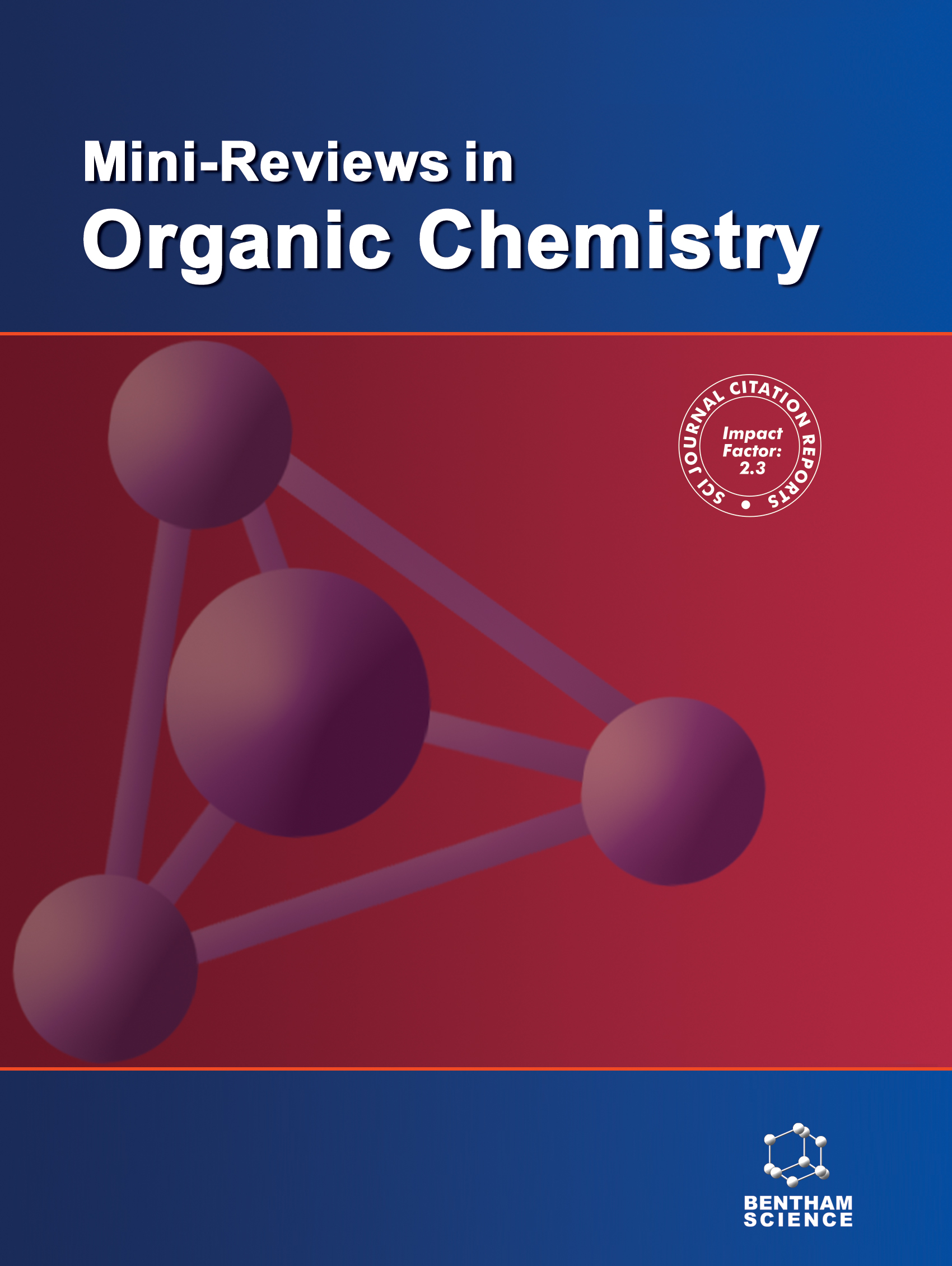- Home
- A-Z Publications
- Mini-Reviews in Organic Chemistry
- Previous Issues
- Volume 18, Issue 6, 2021
Mini-Reviews in Organic Chemistry - Volume 18, Issue 6, 2021
Volume 18, Issue 6, 2021
-
-
Nucleosides and Nucleoside Analogues as Emerging Antiviral Drugs
More LessNucleosides and their analogues have been in use for many years and have become essential for treating patients with viral infections. Many additional nucleoside drugs have been approved over the past decades. This strongly demonstrates how important these compounds are and the crucial role they play. Given that a significant amount of research and literature has been documented regarding nucleoside analogues, Read More
-
-
-
Lactides and Lactones Yielding Eco-Friendly and Biocompatible Polymers by Metal-Catalyzed Ring-Opening Polymerization
More LessAuthors: Jose P. Ruelas-Leyva and Lorenzo A. Picos-CorralesCurrently, there is a growing interest in the development of suitable methods for the preparation of eco-friendly and biocompatible materials in order to increase environmental protection and reduce human health risk. Therefore, this mini-review summarizes several studies involving lactides and lactones as monomers for the synthesis of biodegradable and biocompatible polymers via metal-catalyzed Ring-Opening Polymeriza Read More
-
-
-
Synthetic Strategies for the (+)-Grandisol, the Main Constituent of Boll Weevil Pheromone
More LessThis paper presents a short review of synthetic approaches aiming to synthesise (+)- Grandisol, the main constituent of grandlure, a pheromone mixture released by the boll weevil, which is proven to exhibit significant biological activity. (+)-Grandisol 1 is among the components of the male-produced pheromone of the boll weevil Anthonomuns grandis, an important pest of cotton crops in Mesoamerica (from the south USA t Read More
-
-
-
A Comprehensive Overview of the Synthesis of Tetrahydrocarbazoles and its Biological Properties
More LessAuthors: Subhendu Chakroborty and Pravati PandaTetrahydrocarbazoles (THC) is a privileged structural scaffold containing natural indole as the central moiety. This extraordinary skeleton features in a plethora of naturally occurring pharmacological compounds and alkaloids exhibiting a significant inhibitory activity such as antibacterial, protein kinase inhibitor, and tumor growth inhibitor, etc. Due to its versatile biological properties, it always gains considerable attention among t Read More
-
-
-
Fish Gelatin Hydrolysates as Antioxidant, Antihypertensive, and Antidiabetic: The Plausible Mechanisms
More LessBy Yoni AtmaGelatin produced from fish processing by-product is the most potential alternative source of gelatin. They have biological activities, particularly antioxidant, antihypertensive, and reduce type 2 diabetic risk. This paper reviews the mechanisms of fish gelatin hydrolysates for those human diseases being discussed in recent studies. Based on the review, mostly, skin and bone are used as sources of fish-based gelatin in whic Read More
-
-
-
Plant-Mediated Synthesis of Iron Oxide Nanoparticles and Evaluation of the Antimicrobial Activity: A Review
More LessAuthors: Abderrhmane Bouafia and Salah E. LaouiniIn this review, we examine ‘greener’ routes to nanoparticles of iron oxides, in the recent years; nanotechnology has emerged as a state-of-the-art and cutting edge technology with multifarious applications in a wide array of fields. Natural products or extracted from natural products, such as different plant extracts, have been used as reductants and as capping agents during synthesis. A very easy, efficient, and environment-f Read More
-
-
-
The Synthesis and Anticancer Potentials of Quinoline Analogues: A Review of Literature
More LessAuthors: Ajay Kumar, Salahuddin, Avijit Mazumder, Mohammad S. Yar, Rajnish Kumar and Mohamed Jawed AhsanNew drugs introduced in the market each year, have privileged structures specifically for anticancer targets, of which quinoline-based analogues also play an important role. This review highlights quinoline and its derivatives, which have great potency against various cancer cells, including prostate cancer, breast cancer, colon cancer, pancreas cancer, and many more. This review describes the most preferred process-scal Read More
-
-
-
Review on the Synthetic Methods of Biologically Potent Benzoxazole Derivatives
More LessAuthors: Subramaniyan Arulmurugan, Helen P. Kavitha and Jasmine P. VennilaBenzoxazole compounds have an important and broad range of biological activities. The benzoxazole and its substituted derivatives possess antimicrobial, antitumor, anti-inflammatory, antihistaminic, anti-parasitic, herbicidal, anti-allergic, anti-helmintic, anti-tubercular, anticonvulsant, hypoglycaemic, HIV-1 reverse transcriptase inhibitor and insecticidal activities. It has also been shown to have a binding affinity to Aβ42 Read More
-
-
-
The Synthesis and Chemistry of 2-Imino-2H-Chromene-3-Carbo(Thio) Amides
More Less2-Imino-2H-chromene-3-carbo(thio)amides are considered versatile compounds because of their significance as building blocks in synthetic chemistry. In this review, we display all the available synthetic methods for 2-imino-2H-chromene-3-carbo(thio)amides as well as their reactions towards the different reagents. The presence of the imino and amide groups in these compounds makes C-4 the only reactive site of the Read More
-
-
-
Plants as a Promising Reservoir of Tyrosinase Inhibitors
More LessAuthors: Rabia Riaz, Salma Batool, Paolo Zucca, Antonio Rescigno, Stefania Peddio and Rahman S. Z. SaleemThe process of melanogenesis that takes place in the melanocytes of the epidermis, leads to hyperpigmentation. The biosynthetic pathway for the production of melanin involves the enzyme tyrosinase that has been an attractive target for cosmaceutical research. Numerous synthetic, semisynthetic and natural, especially plant-based, inhibitors of tyrosinase have been reported in the literature. In plants, the secondary Read More
-
Volumes & issues
-
Volume 22 (2025)
-
Volume 21 (2024)
-
Volume 20 (2023)
-
Volume 19 (2022)
-
Volume 18 (2021)
-
Volume 17 (2020)
-
Volume 16 (2019)
-
Volume 15 (2018)
-
Volume 14 (2017)
-
Volume 13 (2016)
-
Volume 12 (2015)
-
Volume 11 (2014)
-
Volume 10 (2013)
-
Volume 9 (2012)
-
Volume 8 (2011)
-
Volume 7 (2010)
-
Volume 6 (2009)
-
Volume 5 (2008)
-
Volume 4 (2007)
-
Volume 3 (2006)
-
Volume 2 (2005)
-
Volume 1 (2004)
Most Read This Month
Article
content/journals/mroc
Journal
10
5
false
en


